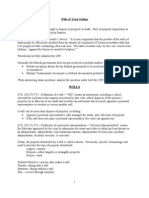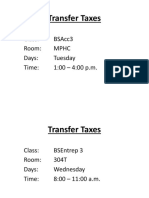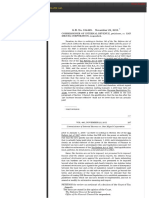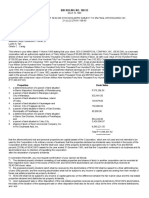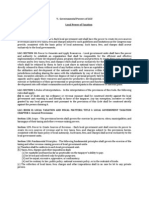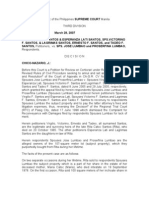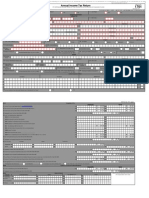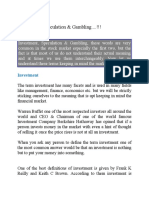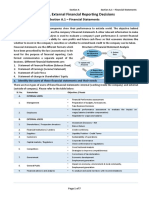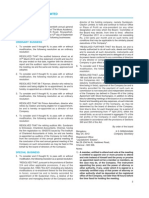Value Added Tax
Value Added Tax
Uploaded by
Nori LolaCopyright:
Available Formats
Value Added Tax
Value Added Tax
Uploaded by
Nori LolaOriginal Description:
Copyright
Available Formats
Share this document
Did you find this document useful?
Is this content inappropriate?
Copyright:
Available Formats
Value Added Tax
Value Added Tax
Uploaded by
Nori LolaCopyright:
Available Formats
12/8/15
TAX
2
VAT
INTRODUCTION
A"y. Terence Conrad H. Bello
A. Features of VAT
A. Features of VAT
1. Essen?al Features of VAT:
a. Tax on consump?on
2. Method of collec?ng VAT through the tax credit
method
Input tax is credited against output tax to arrive at
net VAT payable (net VAT payable is eec?vely the
tax on the value added)
Illustra(on: tax credit method and tax on value
added
Assume there are four rms (1) a logging
concessionaire who also manufactures lumber, (2) a
furniture manufacturer, (3) a furniture wholesaler,
and (4) a furniture retailer who sells furniture to the
end consumer, which is the household
b. Limited to value added
c. It is an indirect tax
A"y. Terence Conrad H. Bello
Slide No. 3
A"y. Terence Conrad H. Bello
Slide No. 4
12/8/15
A. Features of VAT
Taxpayer
A. Features of VAT
Sales
Value Output
Price
Added
Tax
Input
VAT
Tax
Payable
Concessionaire
10.00 10.00 1.00
- 1.00
Manufacturer
25.00 15.00 2.50 1.00 1.50
Wholesaler
40.00 15.00 4.00 2.50 1.50
Retailer
50.00 10.00 5.00 4.00 1.00
Household: purchase price (P50) + VAT (P5) = P55
5.00
*
For
illustra,on
purposes
only,
the
VAT
rate
used
in
the
example
is
10%
(the
rate
now
is
12%)
A"y.
Terence
Conrad
H.
Bello
Slide No. 5
3. Output and Input
a. The VAT on the concessionaires sale of lumber is known as
output tax
b. The output tax, when it is passed on the purchaser who
manufactures the lumber into furniture, becomes the
manufacturers input tax
c. The sale of furniture by the manufacturer to the wholesaler
is likewise subject to VAT (output tax); however, he is
en?tled to deduct from such output tax, the input tax which
is shiYed to him by the concessionaire
4. Basic formula:
Output tax (12% or 0%)
Less: input tax_______
VAT Payable
A"y. Terence Conrad H. Bello
Slide No. 6
A. In General
I.
1. Taxable transac?ons covered:
a. Sale of goods or proper?es (in the course of T or
B)
b. Importa?on of goods (W/N in the course of T or
B)
c. Sale of services (in the course of T or B)
2. General requirements (sale of goods and services)
a. There is a sale (of goods or services); AND
b. The sale is made in the course of trade or
business
TAXABLE TRANSACTIONS
A"y. Terence Conrad H. Bello
A"y. Terence Conrad H. Bello
Slide No. 8
12/8/15
A. In General; 1st Requirement; There is a Sale
A. In General; 1st Requirement; There is a Sale
1. In order for a transac?on to be subjected to VAT, it is essen?al
that there is a sale of goods or services
2. Illustra?ve cases
VAT Rul. No. 26-97
TP shares the same building with 2 or more subsidiaries
Being the nominal party-lessee (i.e., lessee-of-record), TP
advances the payment of rent to the lessor, then seeks
reimbursement from its co-lessees (the subs) for their
propor?onate share of the rent, without mark-up or prot
element (i.e., reimbursement-of-cost basis)
Same treatment for other expenses such as security, building
maintenance and u?li?es (TP advances the expenses then
seeks reimbursement from the subs)
Ruling: reimbursements not subject to VAT since TP does not
sell, barter, exchange or lease goods or property or renders
services
A"y. Terence Conrad H. Bello
Slide No. 9
A. In General; 1st Requirement; There is a Sale
A"y. Terence Conrad H. Bello
Slide No. 10
A. In General; 2nd Requirement; Sale is in the Course of Trade or Business
2. Illustra?ve
cases
See,
however,
VAT
Rul.
18-98,
wherein
an
HMO
was
considered as engaged in business as a service
contractor and was held liable to pay VAT although
the actual health care services were rendered by
independent health care providers
In Tourist Trade, the TP therein was neither selling
electricity, water, etc. nor rendering janitorial and
security services
In VAT Rul. 18-98, the TP therein sold health care
services through independent third par?es who
actually performed the service on the TPs behalf
A"y. Terence Conrad H. Bello
2. Illustra?ve
cases
See
also
Tourist
Trade
and
Travel
Corp.
v.
CIR
wherein
reimbursements
received
by
a
mall
owner
for
advances
it
had
made
for
the
payment
of
electric,
water,
and
telephone
bills
and
for
the
janitorial
services
provided
were
held
to
be
not
subject
to
VAT
since
the
TP
was
not
engaged
in
the
business
of
providing
electricity,
water,
security
and
janitorial
services
to
the
lessees
Court
reasoned
that
it
is
not
TP
who
directly
supplied
electricity,
water
and
similar
other
goods
to
the
lessees,
neither
did
it
render
security
and
janitorial
services
Slide No. 11
1. An important requirement for imposi?on of VAT is that
the sale or transac?on has been entered into in the
course of any business carried on by the TP
2. The phrase in the course of trade or business means:
the regular conduct or pursuit of a commercial or an
economic ac?vity
including transac?ons incidental thereto
regardless of W/N the person engaged therein is a
non-stock, non-prot private organiza?on
(irrespec?ve of the disposi?on of its net income and
whether or not it sells exclusively to members or
their guests), or government en?ty ( 105)
A"y. Terence Conrad H. Bello
Slide No. 12
12/8/15
A. In General; 2nd Requirement; Sale is in the Course of Trade or Business
3. Thus the phrase in the course of trade or business connotes
REGULARITY
Thus, a non-stock corpora?on whose primary purpose is to
engage in research ac?vi?es and to provide services (for a fee)
in community organiza?on, development planning and
development livelihood, development communica?on and
rural resource management was held subject to VAT. BIR Rul.
1-94, Jan. 4, 1994
On the other hand, the factor of regularity was absent in BIR
Rul. 98-97, Aug. 28, 1997, which involved a manufacturer and
exporter of goods that received a considera?on for agreeing
to pre-terminate its lease contract and to cancel its purchase
op?on over the leased premises. The BIR ruled that the lease
pre-termina?on and cancella?on of purchase op?on does not
cons?tute a sale, barter or exchange of goods or proper?es in
the course of trade or business of TP which is engaged in the
manufacture and expor?ng of goods
A"y. Terence Conrad H. Bello
Slide No. 13
A. In General; 2nd Requirement; Sale is in the Course of Trade or Business
5. Is prot mo?ve/element essen?al for taxability? No
CIR v. Commonwealth Mgt. & Services Corp.
TP is an aliate of Philamlife organized by the la"er to
perform collec?on, consulta?ve and other technical
services, including func?oning as an internal auditor of
Philamlife and its other aliates
TP assessed by the BIR for deciency VAT
Conten?ons of TP:
It was not engaged in the business of providing services
to its aliates since the services were on a no prot,
reimbursement-of-cost basis only; not prot oriented
= not engaged in business
In fact it did not generate prot but suered a net loss
during the tax year at issue
In the course of T or B requires that the business is
carried on with a view to prot or livelihood
A"y. Terence Conrad H. Bello
Slide No. 15
A. In General; 2nd Requirement; Sale is in the Course of Trade or Business
5. Is prot mo?ve/element essen?al for taxability?
No. Thus, a company that intends to establish a consumer
store for the benet of its employees where there will be no
value added to the goods sold because they will be sold at cost
was held liable to VAT. The absence of prot and value added
to the goods sold does not make a person opera?ng a
consumer store selling basic commodi?es at cost exempt from
VAT. VAT Rul. No. 444-88, Sept. 13, 1988
In BIR Rul. 10-98, Feb. 5, 1998, the BIR ruled that a TP whose
primary purpose as set forth in its AOI is to provide technical,
research, management and personnel assistance to aliates
on a reimbursement-of-cost basis (i.e., no mark-up or prot
element) is subject to VAT
the phrase sale or exchange of services includes, among
others, the supply of technical service, assistance or
services rendered in connec?on with technical mgt or
administra?on of any scien?c, industrial or commercial
undertaking, project or scheme
A"y. Terence Conrad H. Bello
Slide No. 14
A. In General; 2nd Requirement; Sale is in the Course of Trade or Business
5. Is prot mo?ve/element essen?al for taxability? No
CIR v. Commonwealth Mgt. & Services Corp.
Issue: Whether TP was engaged in the sale of service, thus
liable for VAT
Held: Liable for VAT
Even a non-stock, non-prot organiza?on or government en?ty
is liable to pay VAT on the sale of goods or services
VAT is a tax on transac?ons, imposed at every stage of the
distribu?on process on the sale, barter, exchange of goods or
property, and on the performance of services, even in the
absence of prot a"ributable thereto
The term in the course of trade or business requires the
regular conduct or pursuit of a commercial or an economic
ac?vity, regardless of whether or not the en?ty is prot-
oriented
A"y. Terence Conrad H. Bello
Slide No. 16
12/8/15
A. In General; 2nd Requirement; Sale is in the Course of Trade or Business
5. Is prot mo?ve/element essen?al for taxability? No
CIR v. Commonwealth Mgt. & Services Corp.
Hence, it is immaterial whether the primary purpose of a
corpora?on indicates that it receives payments for
services rendered to its aliates on a reimbursement-on-
cost basis only, without realizing prot, for purposes of
determining liability for VAT on services rendered
As long as the en?ty provides service for a fee,
remunera?on or considera?on, then the service rendered
is subject to VAT
The services of TP do not fall within the 109
enumera?on of exempt transac?ons
A"y. Terence Conrad H. Bello
Slide No. 17
A. In General; 2nd Requirement; Sale is in the Course of Trade or Business; Incidental
Transac?on vs. Isolated Transac?on
2. However, the BIR (and even the courts) in certain
instances exempted from VAT the sale of property used
in business supposedly because the sale was an isolated
transac?on
See BIR Rul. 113-98, where the BIR ruled that the
sale by a telecom company of its microwave
backbone transmission network to another wireless
communica?ons carrier is not in the course of the
TPs trade or business of selling telecommunica?on
services
The BIR explained that the sale is not subject to
VAT because it is an isolated transac?on; and
that the transac?on does not necessarily follow
the primary func?on of selling telecom services
A"y. Terence Conrad H. Bello
Slide No. 19
A. In General; 2nd Requirement; Sale is in the Course of Trade or Business; Incidental
Transac?on vs. Isolated Transac?on
1. By express provision of law ( 105), incidental transac?ons are
considered as undertaken in the course of business
Incidental means depending upon or appertaining to
something else as primary; something necessary,
appertaining to, or depending upon another which is termed
the principal
Hence, the sale by a garments manufacturer of a motor
vehicle assigned to its GM is subject to VAT
The sale of the motor vehicle is an incidental transac?on
because the vehicle was purchased and used in
furtherance of the TPs business. CS Garments v. CIR,
CTA Case 6520, Jan. 4, 2007
Posi?on adopted by BIR in RMO 15-2011 when it
revoked rulings exemp?ng sale of company car from VAT
A"y. Terence Conrad H. Bello
Slide No. 18
A. In General; 2nd Requirement; Sale is in the Course of Trade or Business; Incidental
Transac?on vs. Isolated Transac?on
See
also
Magsaysay
Lines,
Inc.
v.
CIR,
CTA
Case
No.
4353,
April
27,
1992,
a.
in
G.R.
No.
146984,
July
28,
2006,
where
the
court
held
that
the
sale
by
a
property
lessor,
a
GOCC,
of
its
vessels
held
out
for
lease
in
line
with
the
governments
priva?za?on
program
is
not
subject
to
VAT
Court
held
that
the
sale
was
an
isolated
transac?on;
the
sale
which
was
involuntary
and
made
pursuant
to
the
declared
policy
of
government
for
priva?za?on
could
no
longer
be
repeated
or
carried
on
with
regularity;
it
should
be
emphasized
that
the
normal
VAT-registered
ac?vity
of
the
TP
is
leasing
personal
property;
the
sale
of
the
vessels
as
such
are
not
necessary
to
carry
out
the
TPs
primary
func?on
of
leasing
personal
proper?es
Without
analysis,
the
court
held
that
the
sale
was
not
incidental
to
the
TPs
normal
business
of
leasing
property
([t]he
act
of
selling
capital
assets
does
not
necessarily
follow
the
act
of
leasing
these
assets)
A"y. Terence Conrad H. Bello
Slide No. 20
12/8/15
A. In General; 2nd Requirement; Sale is in the Course of Trade or Business; Incidental
Transac?on vs. Isolated Transac?on
Lapanday Food Corp. v. CIR
Interest income derived by a parent company
from intercompany loans to aliates, as a form
of nancial assistance, is considered services
incidental to the parents business and, thus,
subject to VAT
A"y. Terence Conrad H. Bello
Slide No. 21
A. In General; 2nd Requirement; Sale is in the Course of Trade or Business; Incidental
Transac?on vs. Isolated Transac?on
3. The mere fact that a transac?on is isolated will not
necessarily disqualify it from being made incidentally in
the course of trade or business
4. Thus, an isolated transac?on -- if at the same ?me is
an incidental transac?on -- will be characterized as
entered into in the course of trade or business,
hence, subject to VAT
A"y. Terence Conrad H. Bello
Slide No. 23
A. In General; 2nd Requirement; Sale is in the Course of Trade or Business; Incidental
Transac?on vs. Isolated Transac?on
Mindanao II Geothermal Partnership v. CIR
However, it does not follow that an isolated transac?on
cannot be an incidental transac?on for purposes of VAT
liability
A reading of Sec?on 105 of the 1997 Tax Code would show
that a transac?on in the course of trade or business
includes transac?ons incidental thereto
Mindanao IIs business is to convert the steam supplied to it
by PNOC-EDC into electricity and to deliver the electricity to
NPC. In the course of its business, Mindanao II bought and
eventually sold a Nissan Patrol. Prior to the sale, the Nissan
Patrol was part of Mindanao IIs property, plant, and
equipment. Therefore, the sale of the Nissan Patrol is an
incidental transac?on made in the course of Mindanao IIs
business which should be liable for VAT
A"y. Terence Conrad H. Bello
Slide No. 22
B. Sale of Goods or Proper?es
1. Sec. 106: there shall be levied, assessed and
collected on every sale, barter or exchange of goods
or proper?es, a value-added tax equivalent to 12%
of the gross selling price
2. What are the taxable transac?ons covered by
106?
a. Actual sales
b. Deemed sale transac?ons
c. Changes in or cessa?on of status of a VAT-
registered person
A"y. Terence Conrad H. Bello
Slide No. 24
12/8/15
B. Sale of Goods or Proper?es: Actual Sale
B. Sale of Goods or Proper?es: Deemed Sale Transac?ons
1. A sale is a transfer of goods to another either (a) for
cash or on credit, or (b) partly for cash and partly for
credit
2. Covers sales, barters and exchanges
3. VAT accrues upon consumma?on of the sale,
regardless of the terms of payment between the
contrac?ng par?es (implicit in the deni?on of gross
selling price, which includes money or money
equivalent which the purchaser is obligated to pay);
unlike sale of services wherein VAT accrues only upon
payment of considera?on (when the gross receipts
are actually or construc?vely received by the seller)
A"y. Terence Conrad H. Bello
Slide No. 25
B. Sale of Goods or Proper?es: Deemed Sale Transac?ons
A"y. Terence Conrad H. Bello
Slide No. 26
B. Sale of Goods or Proper?es: Deemed Sale Transac?ons
3. Ra?onale for taxing deemed sale
transac?ons:
To recapture/recoup claimed input tax
a"ributable to the taxable goods withdrawn for
personal or non-business use
A"y. Terence Conrad H. Bello
1. VAT on goods and proper?es not limited to actual sales; also
covers certain transac?ons which the law deems as if it was an
actual sale, hence, subject to VAT
2. What are the deemed sale transac?ons?
a. Transfer, use or consump?on not in the course of business of
goods or proper?es originally intended for sale or use in the
course of business
b. Distribu?on or transfer to (i) shareholders or investors as
share in the prots of the VAT-registered TP; or (ii) creditors in
payment of debt
c. Consignment of goods if actual sale is not made within 60 days
d. Re?rement from or cessa?on of business with respect to
inventories of taxable goods exis?ng as of such re?rement or
cessa?on ( 106(B))
Slide No. 27
4. Illustra?on of input tax recapture:
TP bought merchandise (say 10 t-shirts) for P1,000; VAT
of P100 was passed on to him by the store that sold him
the t-shirts (total purchase price therefore is P1,100); TP
intends to sell the t-shirts @ P220 each for a total of
P2,200 (VAT inclusive). For the sale of the t-shirts, TP has
a VAT payable of P100 (P200 output less P100 input)
Instead of selling everything, TP withdraws for his
personal use 3 t-shirts and sold the remaining 7 t-shirts;
without the deemed sale provisions, TP has a VAT
payable only of P40 (output of P140 less input of P100)
Without deemed sale provisions, government foregoes
P60 of VAT revenue
With the deemed sale provisions, government is
restored to P100 VAT posi?on
A"y. Terence Conrad H. Bello
Slide No. 28
12/8/15
B. Sale of Goods or Proper?es: Deemed Sale Transac?ons
B. Sale of Goods or Proper?es: Changes in or Cessa?on of Status of VAT-Registered TP
5. Examples of deemed sale transac?ons:
106(B)(1) Mr. K sells household furniture; he removes from
his store a living room set for use in his residen?al house
106(B)(2)(a) J Co. declared a property dividend out of
inventory
106(B)(2)(b) M Co. is indebted to N Co. for raw materials;
when M Co. could not pay in money, N Co. agreed to a dacion
of the nished goods in payment of the indebtedness
106(B)(3) TP sold goods on consignment to A, with ?tle to
the goods passing only upon sale to a buyer; 65 days aYer
consignment, goods s?ll unsold by A
106(B)(4) - P & Co. was a taxable partnership; P & Co. was
dissolved and Q & Co. was formed to con?nue the business of
P & Co; at the ?me that P & Co. was dissolved, its books of
accounts showed a merchandise inventory of P100,000; the
inventory is deemed sold by P & Co. upon dissolu?on
A"y. Terence Conrad H. Bello
Slide No. 29
B. Sale of Goods or Proper?es: Taxable Base; Gross Selling Price
A"y. Terence Conrad H. Bello
Slide No. 30
B. Sale of Goods or Proper?es: Taxable Base; Gross Selling Price
1. Taxable base means the amount or the value on which
the VAT rate will be applied in compu?ng the output tax
For a taxable person who sells goods or proper?es,
the taxable base is the gross selling price
Gross selling price means the total amount of
money or its equivalent which the purchaser pays or
is obligated to pay to the seller in considera?on of
the sale, barter or exchange of the goods or
proper?es, excluding VAT. The excise tax, if any, on
such goods or proper?es shall form part of the gross
selling price.
Special rules for sale of real property (FMV or zonal
value, whichever is higher; taxable base for VAT may
be accounted for under the instalment method)
A"y. Terence Conrad H. Bello
1. VAT also applies to goods disposed of or exis?ng under certain
circumstances
Example: change of business ac?vity from VAT-taxable
status to VAT-exempt status
Illustra?on: VAT-registered person engaged in a taxable
ac?vity like wholesaler or retailer who decides to
discon?nue such ac?vity and engages instead in life
insurance business or in any other business not subject
to VAT
Goods exis?ng as of the change in status from VATable
to VAT-exempt become subject to VAT even in the
absence of an actual sale
Ra,onale: same as deemed sale transac?ons (input tax
recapture)
Slide No. 31
2. Timing issues; when VAT accrues computa?on of
taxable base for sales of goods or proper?es is
dierent from that of supply of services
Sale of goods or proper?es generally requires the
use of the accrual method on the basis of the
statutory deni?on of gross selling price (total
amount of money or its equivalent that the
purchaser pays or is obligated to pay to the seller)
Sale of services cash method of accoun?ng,
which means the considera?on is taxable only
upon actual or construc?ve receipt, regardless of
W/N the service has been rendered (see statutory
deni?on of gross receipts)
A"y. Terence Conrad H. Bello
Slide No. 32
12/8/15
B. Sale
of
Goods
or
Proper?es:
Taxable
Base;
Gross
Selling
Price;
Sales
Discount,
Returns,
&
Allowance
1. Sales
discounts
and
returns
and
allowances
as
allowable
deduc?ons
from
gross
selling
price
a. For
sales
discounts
discount
must
be
indicated
in
the
invoice
at
the
?me
of
sale,
the
grant
of
which
is
not
dependent
upon
the
happening
of
a
future
event
Illustra,on:
TP
grants
discounts
to
ice
cream
houses
in
the
form
of
rebates
for
mee?ng
monthly
sales
quota;
rebates
are
determined
only
at
the
end
of
the
month
Answer:
Deduc?on
not
allowed.
Discounts
condi?oned
upon
the
subsequent
happening
of
an
event
or
fulllment
of
certain
condi?ons,
such
as
prompt
payment
or
a"ainment
of
sales
goals,
shall
not
be
allowed
as
deduc?ons.
Only
discounts
granted
and
determined
at
the
?me
of
sale
which
are
indicated
in
the
invoice
are
allowed
as
deduc?ons
from
the
gross
selling
price.
BIR
Rul.
No.
204-90
b. For
sales
returns
and
allowances
proper
credit
or
refund
was
made
during
the
month
or
quarter
to
the
buyer
for
sales
previously
recorded
as
taxable
sales
A"y.
Terence
Conrad
H.
Bello
Slide No. 33
C. Importa?on of Goods
1. Transac?ons deemed sale - output tax shall be based on
the market value of the goods deemed sold as of the
?me of the occurrence of the deemed sale transac?ons
enumerated in Sec. 4.106-7(a)(1),(2), and (3)
2. Re?rement or cessa?on of business - tax base shall be
the acquisi?on cost or the current market price of the
goods or proper?es, whichever is lower
3. Sale where the gross selling price is unreasonably lower
than FMV - the actual market value shall be the tax base
Meaning of unreasonably lower - if GSP is lower by
more than 30% of the actual market value of the
same goods of the same quan?ty and quality sold in
the immediate locality on or nearest the date of sale
A"y. Terence Conrad H. Bello
Slide No. 34
C. Importa?on of Goods
1. In general - VAT is imposed on goods brought into the
Philippines, whether for use in business or not
2. Tax base VAT is based on the total value used by the
BOC in determining tari and customs du?es, plus
customs du?es, excise tax, if any, and other charges,
such as postage, commission, and similar charges, prior
to the release of the goods from customs custody
3. If du?es based on volume or quan?ty - landed cost shall
be the basis for compu?ng VAT. Landed cost consists of
the invoice amount, customs du?es, freight, insurance
and other charges. If the goods imported are subject to
excise tax, the excise tax shall form part of the tax base
A"y. Terence Conrad H. Bello
B. Sale of Goods or Proper?es: Taxable Base; Deemed Sales, Re?rement and
Cessa?on, Below Market GSP
Slide No. 35
4. Importa?on of 109(1) exempt goods no VAT
5. Time for payment prior to release from customs
custody
A"y. Terence Conrad H. Bello
Slide No. 36
12/8/15
D. Sale of Services; Meaning of Sale or Exchange of Services
D. Sale of Services; Requirements for Taxability
1. Sale or exchange of services - means the
performance of:
all kinds of services
in the Philippines
for others for a fee, remunera?on or
considera?on, whether in kind or in cash
including those performed or rendered by certain
persons and those involving certain transac?ons
enumerated under the law (see enumera?on;
enumera?on is not exclusive; see Lhuiller v. CIR)
and similar services regardless of whether or not
the performance thereof calls for the exercise or
use of the physical or mental facul?es
A"y. Terence Conrad H. Bello
Slide No. 37
D. Sale of Services; Requirements for Taxability; Place of Performance Rule
1. As a statutory principle, all kinds of services performed in
the Philippines are subject to VAT at the rate of 12% or 0%
2. Services performed outside the Philippines, even if
undertaken in the course of business, are beyond the
scope of VAT, therefore, not subject to VAT
The place where the service is performed determines
the jurisdic?on to impose VAT (place of payment is
immaterial since the situs of the service is determined
by the place where the service is performed)
Thus, marke?ng ac?vi?es of a realty broker in the U.S.
to en?ce OFWs to buy condo units in the Philippines
held not subject to VAT since services were rendered
outside the Philippines. BIR Rul. 110-97
A"y. Terence Conrad H. Bello
Slide No. 39
What are the requirements for the taxability of sale of
services?
The service must be in the course of trade or
business;
Note: services rendered in the Philippines by non-
resident foreign persons are considered as having
been rendered in the course of trade or business
The service must be performed in the Philippines;
and
The considera?on is actually or construc?vely
received
A"y. Terence Conrad H. Bello
Slide No. 38
D. Sale of Services; Requirements for Taxability; Place of Performance Rule
Legal services performed by a U.K. law rm in
the U.K. and in the U.S. for the Republic of the
Philippines in an arbitra?on case in Washington,
DC not subject to VAT. ITAD Rul. 154-02
A"y. Terence Conrad H. Bello
Slide No. 40
10
12/8/15
D. Sale of Services; Taxable Base; Gross Receipts Actually & Construc?vely Received
D. Sale of Services; Taxable Base; Gross Receipts Actually & Construc?vely Received
1. Deni?on of gross receipts
refers to the total amount of money or its equivalent
represen?ng the contract price, compensa?on,
service fee, rental or royalty,
including the amount charged for materials supplied
with the services and deposits applied as payments
for services rendered and advance payments
actually or construc?vely received during the taxable
period
for the services performed or to be performed for
another person,
excluding VAT
2. Although taxable transac?on is past, present, or future
performance of service tax accrues upon actual or
construc?ve receipt
3. Tax accoun?ng cash method (not accrual method)
4. Construc?ve receipt occurs when the money
considera?on or its equivalent is placed at the control of
the person who rendered the service without
restric?ons by the payor. Examples:
Deposit in banks which are made available to the
seller of services without restric?ons;
Issuance by the debtor of a no?ce to oset any debt
or obliga?on and acceptance thereof by the seller as
payment for services rendered; and
Transfer of the amounts retained by the payor to the
account of the contractor
A"y. Terence Conrad H. Bello
Slide No. 41
A"y. Terence Conrad H. Bello
Slide No. 42
D. Sale
of
Services;
Taxable
Base;
Gross
Receipts
Actually
&
Construc?vely
Received;
Inclusions
and
Exclusions
D. Sale
of
Services;
Taxable
Base;
Gross
Receipts
Actually
&
Construc?vely
Received;
Inclusions
and
Exclusions
1. Includes:
Contract
price,
compensa?on,
service
fee,
rentals
or
royal?es
Amount
charged
for
materials
supplied
with
the
services
Deposits
and
advance
payments
2. Thus,
gross
receipts
includes
amounts
billed
to
clients
intended
to
recover
costs
and
expenses
(e.g.,
salaries
and
wages
due
to
employees,
due
the
government,
deprecia?on
of
equipment,
supplies,
overhead,
etc.)
as
well
as
the
prot
mark-up.
VAT
Rul.
No.
111-88
3. Includes
management
fee
(based
on
prots
of
managed
company),
expenses
incurred
in
connec?on
with
services
rendered,
and
reimbursement
by
managed
company
of
salaries
and
fringe
benets
of
seconded
employee.
VAT
Rul.
No.
205-90
4. Excludes, however, receivables (i.e., por?on of the
contract price not yet actually or construc?vely
received). BIR Rul. No. 195-89
5. Also excludes amounts earmarked for payment to third
par?es as well as reimbursement of out-of-pocket
expenses (under certain condi?ons)
Thus, amounts received by a local travel agent from
foreign tourist agencies which formed part of the
package fee paid by the tourists but were intended
or earmarked for hotel room accommoda?ons and
accordingly paid by the local travel agency to the
hotels not subject to VAT
Gross receipts do not include monies or receipts
entrusted to the TP which do not belong to them
and do not redound to the TPs benet. CIR v. Tours
Specialists, Inc.
A"y. Terence Conrad H. Bello
Slide No. 43
A"y. Terence Conrad H. Bello
Slide No. 44
11
12/8/15
A. Zero Ra?ng vs. Exemp?on
1. Basic principle: a seller who is directly and legally liable
for the payment of VAT on goods and services is not
necessarily the person who ul?mately bears the burden
of the tax
It is the nal purchaser or consumer of such goods
and services who ul?mately bears the burden of the
VAT (VAT being an indirect tax)
2. From the perspec?ve of the nal consumer, VAT zero-
ra?ng and VAT exemp?on both oer some relief from
the burden of taxa?on, but the degree or extent of
relief is dierent
3. VAT exemp?on oers par?al relief from the VAT
incidence, while VAT zero-ra?ng oers total relief from
the VAT incidence (see CIR v. Seagate Tech.)
II. RELIEF FROM VAT
A"y. Terence Conrad H. Bello
45
A. Zero Ra?ng vs. Exemp?on
Slide No. 46
A. Zero Ra?ng vs. Exemp?on
4. Why is the degree of relief dierent?
a. VAT exemp?on (par?al relief)
the transac?on is not subject to VAT (output tax)
but the seller is not allowed any tax credit of VAT
(input tax) on purchases
b. VAT zero-ra?ng (total relief)
the zero-rated sale of goods or services (by a
VAT-registered person) is a taxable transac?on
for VAT purposes, but shall not result in any
output tax (because the output tax rate is 0%)
However, the input tax on purchases of goods,
proper?es or services related to such zero-rated
sale shall be available as tax credit or refund
5. Illustra?on: assume there are 3 sellers A, B, C and a nal
purchaser, D
A"y. Terence Conrad H. Bello
A"y. Terence Conrad H. Bello
Slide No. 47
EXEMPT
VAT
on
selling
price
ZERO-RATED
0
VAT
on
selling
price
Purchase Price
100 Purchase Price
100
VAT passed on
12 VAT passed on
12
Total amt. charged
A"y. Terence Conrad H. Bello
112 Total amt. charged
112
Refund
(12)
Net amount
100
Slide No. 48
12
12/8/15
B. Zero-Rated Transac?ons
B. Zero-Rated Transac?ons
Objec?ve of zero-ra?ng: to make exporters
compe??ve interna?onally through VAT relief
Two ways to grant relief:
Exporters sale is subject to 0% rate and is
allowed a refund or credit of input tax passed
on to exporter by his supplier (automa?c
zero ra?ng)
Supplier of exporter is eec?vely zero-rated
where his sale to the exporter is subject to
0% rate
A"y. Terence Conrad H. Bello
Slide No. 49
B. Zero-Rated Transac?ons
Supplier
VAT
Total
amt.
charged
to
exporter
Exporter
Customer
100 VAT on sale to
Customer
0 Purchase price
0 Purchase price
100 VAT passed on
100 VAT passed on
Total amt. charged
by supplier
Refund
200
0
0 Total amt. charged
by exporter
200
100
-
Eec?vely, the privilege of zero-ra?ng is extended to
suppliers of the exporter
A"y. Terence Conrad H. Bello
Supplier
Selling
Price
VAT
Total
amt.
charged
to
exporter
Exporter
Customer
100 VAT on sale to
Customer
0 Purchase price
12 Purchase price
100 VAT passed on
112 VAT passed on
A"y. Terence Conrad H. Bello
200
0
12 Total amt. charged
by exporter
Total amt. charged
by supplier
112
Refund
(12)
Net amount
100
200
Slide No. 50
B. Zero-Rated Transac?ons
Eec?ve
zero-ra?ng:
Selling
Price
Automa?c
zero-ra?ng:
Slide No. 51
Sale
of
Goods:
1. Actual
export
sale
(
106(A)(2)(a)(1))
considera?on
in
FX,
accounted
for
in
accordance
with
BSP
rules
and
regs.
2. Sale
of
raw
materials
or
packaging
materials
to
a
nonresident
buyer
for
delivery
to
a
resident
local
export-oriented
enterprise
(
106(A)(2)(a)(2))
considera?on
in
FX,
accounted
for
in
accordance
with
BSP
rules
and
regs.
3. Sale
of
raw/packaging
materials
to
export-oriented
enterprises
(
106(A)(2)(a)(3))
export
sales
must
exceed
70%
of
total
annual
prodn
4. Sale
of
gold
to
BSP
(
106(A)(2)(a)(4))
5. Those
considered
export
sales
under
the
Omnibus
Investments
Code
(
106(A)(2)(a)(5))
A"y.
Terence
Conrad
H.
Bello
Slide No. 52
13
12/8/15
B. Zero-Rated Transac?ons
B. Zero-Rated Transac?ons
Sale
of
Goods:
6. Sale
of
goods,
supplies,
equipment
and
fuel
to
interna?onal
vessels
or
air
carriers
(
106(A)(2)(a)(6))
7. Foreign currency denominated sale ( 106(A)(2)(b))
Sale of goods assembled or manufactured in the Phil. For
delivery to a Phil. resident
e.g., sale of locally manufactured car to OFWs for
delivery to Philippine residents (e.g., family of OFWs in
the Phils.)
8. Sales to persons or en??es whose exemp?on under
special laws or intl agreements eec?vely subjects
such sales to 0% rate ( 106(A)(2)(c)) (e.g., SMBA,
PEZA, ADB, IRRI)
A"y. Terence Conrad H. Bello
Slide No. 53
B. Zero-Rated Transac?ons
A"y. Terence Conrad H. Bello
Slide No. 54
B. Zero-Rated Transac?ons; Accounted for in Accordance with BSP Regs.
Sale
of
Services:
4. Services
rendered
to
interna?onal
vessels
or
air
carriers,
including
leases
of
property
(
108(B)(4))
5. Services
performed
by
contractors
or
subcontractors
in
processing,
conver?ng,
or
manufacturing
goods
for
export-oriented
enterprises
(
108(B)(5))
-
export
sales
must
exceed
70%
of
total
annual
prodn
6. Transport
of
passengers
and
cargo
by
interna?onal
carriers
(
108(B)(6))
7. Sale
of
power
or
fuel
generated
through
renewable
sources
of
energy
(
108(B)(7))
A"y.
Terence
Conrad
H.
Bello
Sale
of
Services:
1. Processing,
mfg.
or
repacking
goods
for
other
persons
doing
business
outside
the
Philippines
which
goods
are
subsequently
exported
(
108(B)(1))
-
considera?on
in
FX,
accounted
for
in
accordance
with
BSP
rules
and
regs.
2. Services
other
than
those
men?oned
in
no.
1
rendered
to
nonresidents
(
108(B)(2))
-
considera?on
in
FX,
accounted
for
in
accordance
with
BSP
rules
and
regs.
CIR
v.
AMEX
CIR
v.
Burmeister
&
Wain
Scandinavian
3. Services
rendered
to
persons
or
en??es
whose
exemp?on
under
special
laws
or
intl
agreements
eec?vely
subjects
such
services
to
0%
rate
(
108(B)(3))
Slide No. 55
1. What is meant by accounted for in accordance with
the rules and regs. of the BSP?
a. Per CB Circ. No. 1389, not required that
considera?on is inwardly remi"ed and converted to
Php (required under old VAT law)
b. At TPs op?on, FX may be
sold for Php to AABs or outside the banking
system, or
retained, or deposited in foreign currency
accounts, whether in the Philippines or abroad
and may be used freely for any purpose. BIR Rul.
No. 176-94, VAT Rul. No. 47-00
A"y. Terence Conrad H. Bello
Slide No. 56
14
12/8/15
C. Exempt Transac?ons
C. Exempt Transac?ons
1. See enumera?on under 109(1) (memorize!)
Sale or importa?on of marine or food products in their
original state
Sale or importa?on of fer?lizers; seeds, seedlings and
ngerlings; etc.
Importa?on of personal and household eects of returning
residents
Services subject to percentage tax
Medical, dental, hospital and veterinary services, except
those rendered by professionals (e.g., doctors, den?sts, vet,
etc.)
Educa?onal services rendered by private educa?onal
ins?tu?ons
Services rendered by RHQ
Transac?ons exempt under special law
Sale of low cost housing, etc.
A"y. Terence Conrad H. Bello
Slide No. 57
2. What is the coverage of the exemp?on?
a. General rule:
Exemp?on covers only taxes for which party favored
by the exemp?on is directly liable; exemp?on does
not extend to indirect taxes like VAT
Being an indirect tax, once VAT is shiYed to the
buyer, it is no longer a tax but an addi?onal cost
which becomes a part of the amount of the contract
price to be paid by the buyer. Phil. Acetylene Co., Inc.
v. CIR; Phil. Natl Police Mul(-Purpose Coopera(ve,
Inc. v. CIR; BIR Rul. No. 155-98; BIR Rul. No. 47-99
A"y. Terence Conrad H. Bello
Slide No. 58
C. Exempt Transac?ons
2. What is the coverage of the exemp?on?
b. Excep?ons:
When the law itself provides for exemp?on
from indirect taxes. CIR v. John Gotamco &
Sons, Inc. (involving the exemp?on of the WHO
from indirect taxes)
When the history of statutes clearly indicates
the grant of indirect tax exemp?on. Maceda v.
Macaraig, Jr. (conrming NPCs exemp?on
from direct and indirect taxes following an
examina?on of the evolu?on of NPCs charter)
A"y. Terence Conrad H. Bello
Slide No. 59
IV. TAX CREDITS AND REFUNDS
A"y. Terence Conrad H. Bello
60
15
12/8/15
A. Input Tax Credit
A. Input Tax Credit
1. What is input tax?
Means the VAT due on or paid by a VAT-registered
person on importa?on of goods or local purchases of
goods, proper?es, or services, including lease or use of
proper?es, in the course of his trade or business.
Also includes the transi?onal input tax and the
presump?ve input tax determined in accordance with
Sec. 111 of the Tax Code
Must be evidenced by a VAT invoice or VAT O/R issued by
a VAT-registered person
2. Who can avail of input tax credit?
VAT-registered importer of goods
VAT-registered purchaser of local goods or proper?es
VAT-registered purchaser of services or lessee or licensee
A"y. Terence Conrad H. Bello
Slide No. 61
A. Input Tax Credit; Excess Output Tax or Input Tax
A"y. Terence Conrad H. Bello
Slide No. 62
A. Input Tax Credit; Amor?za?on of Input Tax on Capital Goods
1. Basic
formula:
Output
tax
(12%
or
0%)
Less:
input
tax_______
VAT
Payable
2. Per
110(B),
if
at
the
end
of
the
taxable
quarter,
output
tax
exceeds
input
tax
VAT-registered
person
pays
the
excess
3. On
the
other
hand,
if
input
tax
exceeds
output
tax:
a. General
rule:
carry-over
excess
input
to
the
succeeding
quarter
or
quarters
b. Excep?on:
if
the
unu?lized
input
is
a"ributable
to
zero-
rated
sales,
the
VAT-registered
TP
has
3
op?ons:
Carry-over
excess
input
tax
Refund
unu?lized
input
tax
Credit
unu?lized
input
tax
vs.
other
internal
revenue
taxes
(i.e.,
TCC)
A"y.
Terence
Conrad
H.
Bello
3. What types of input tax are creditable?
a. Purchase or importa?on of goods:
for sale
for conversion into or intended to form part of a nished
product for sale, including packaging materials
for use as supplies in the course of business
for use as raw materials supplied in the sale of services
for use in trade or business for which deduc?on for
deprecia?on or amor?za?on is allowed
b. Purchase of real proper?es for which a VAT has actually been
paid
c. Purchase of services for which a VAT has actually been paid
d. Transac?ons deemed sale
e. Transi?onal input tax
f. Presump?ve input tax
Slide No. 63
1. Input tax on purchase or importa?on of depreciable goods
must be spread evenly over the month of acquisi?on and the
59 succeeding months if the aggregate acquisi?on cost,
excluding the VAT component, exceeds P1M
2. If the es?mated useful life of the capital good is less than 5
years, the input VAT shall be spread over such shorter period
3. The aggregate acquisi?on cost of a depreciable asset in any
calendar month refers to the total price agreed upon for one
or more assets acquired and not on the payments actually
made during the calendar month. Thus, an asset acquired on
installment for an acquisi?on cost of more than P1M will be
subject to the amor?za?on of input tax despite the fact that
the monthly payment/installment does not exceed P1M
A"y. Terence Conrad H. Bello
Slide No. 64
16
12/8/15
B. Transi?onal Input Tax
C. Presump?ve Input Tax
1. Who is en?tled to the transi?onal input tax?
A person who becomes liable to VAT or any
person who elects to be a VAT-registered person
(e.g., TPs who exceed the P1.5 M threshold or
TPs who elect VAT coverage even if their
turnover does not exceed P1.5 M)
2. How much is the transi?onal input tax?
Transi?onal input tax credit is 2% of the value of
the beginning inventory on hand as of the
eec?vity of the VAT-registra?on, or the actual
VAT paid, whichever is higher
A"y. Terence Conrad H. Bello
Slide No. 65
D. Final Withholding VAT
A"y. Terence Conrad H. Bello
Slide No. 66
E. Claims for Refund or Tax Credit
1. When does it apply?
The 5% nal withholding VAT applies to sales of goods or
services to the government or to GOCCs
2. When does the obliga?on to withhold arise?
Before making payment on account of the purchase, the
government en?ty or the GOCC shall deduct and
withhold the 5% nal VAT based on the gross payment
thereof
3. What does the 5% nal withholding VAT represent?
It represents the net VAT payable of the seller
4. What is the eect of the 5% nal withholding VAT on the
sellers input tax a"ributable to the sale to the government
or the GOCC?
It essen?ally limits the amount of input VAT that the
seller may credit against the 12% output tax to only 7%
(12% output - 5% net VAT payable = 7% standard input)
A"y. Terence Conrad H. Bello
1. Who is en?tled to the presump?ve input tax?
Persons or rms engaged in the processing of
s a r d i n e s , m a c k e r e l , a n d m i l k , a n d i n
manufacturing rened sugar, cooking oil and
packed noodle-based instant meals
2. How much is the presump?ve input tax?
4% of the gross value in money of the TPs
purchases of primary agricultural products which
are used as inputs to their produc?on
Slide No. 67
1. When can a VAT-registered TP claim a refund
or tax credit for unu?lized input VAT?
In only 2 instances:
Zero-rated or eec?vely zero-rated sales (
112(A)) unu?lized input VAT must be
a"ributable to the zero-rated sales (i.e., either
directly a"ributable or allocable to zero-rated
sales)
Cancella?on of VAT registra?on ( 112(B)) - due
to re?rement from or cessa?on of business, or
due to changes in or cessa?on of status under
106(C)
A"y. Terence Conrad H. Bello
Slide No. 68
17
12/8/15
E. Claims for Refund or Tax Credit
E. Claims for Refund or Tax Credit
2. What
is
the
period
within
which
the
CIR
should
act
on
the
claim?
Within
120
days
from
submission
of
complete
documents
in
support
of
the
applica?on
3. What
is
the
prescrip?ve
period
for
ling
the
claim
for
refund
or
TCC?
a. In
the
case
of
zero-rated
sales:
Administra?ve
claim
must
be
made
within
2
years
from
from
the
close
of
the
taxable
quarter
when
the
relevant
sales
were
made
(CIR
v.
Mirant
Pagbilao
Corp.,
GR
172129,
Sept.
12,
2008)
Judicial
claim
Within
30
days
from
denial
of
claim
or
from
the
lapse
of
the
120
day
period
without
any
ac?on
from
the
BIR
(
112(A))
(CIR
v.
Aichi
Forging,
GR
184823,
Oct.
6,
2010)
CIR
v.
San
Roque
Power
Corp.,
GR
187485,
Feb.
12,
2013
Upon
the
lapse
of
the
120-day
period,
may
TP
await
instead
for
an
actual
denial?
Rohm
Apollo
Semiconductor
Phil.
v.
CIR
A"y.
Terence
Conrad
H.
Bello
Slide No. 69
3. What is the prescrip?ve period for ling the claim
for refund or TCC?
b. In the case of cancella?on of VAT registra?on:
Administra?ve claim must be made within 2
years from the date of cancella?on
Judicial claim same
A"y. Terence Conrad H. Bello
Slide No. 70
A. BIR Registra?on
1. Mandatory registra?on generally, any person
whose sale of goods and services are subject to VAT
is required to register as a VAT taxpayer with the
appropriate RDO (and pay annual registra?on fee of
P500). VAT registra?on is mandatory if:
TPs gross sales or receipts for the past 12 mos.
(other than exempt sales) exceed P1,919,500
TP has reasonable grounds to believe that his
gross sales or receipts for the next 12 mos.
(other than exempt sales) will exceed P1,919,500
V. COMPLIANCE REQUIREMENTS
A"y. Terence Conrad H. Bello
71
A"y. Terence Conrad H. Bello
Slide No. 72
18
12/8/15
A. BIR Registra?on
A. BIR Registra?on
2. Op?onal registra?on TP may elect to register as a
VAT taxpayer in the following instances:
TPs annual gross sales or receipts do not exceed
P1,919,500
TP with mixed transac?ons (taxable and
exempt), may elect that exempt transac?ons be
subject to VAT
Franchise grantees of radio and TV broadcas?ng
whose annual gross receipts of the preceding
year do not exceed P10M
A"y. Terence Conrad H. Bello
Slide No. 73
A. BIR Registra?on
A"y. Terence Conrad H. Bello
Slide No. 74
B. Record Keeping Requirement
4. Cancella?on of VAT registra?on
TP is previously VAT-registered but whose annual
gross sales or receipts fall below P1,919,500
Re?rement from business subject to VAT
A"y. Terence Conrad H. Bello
3. Consequences
of
non-registra?on
TP
liable
for
VAT
But
disqualied
to
claim
input
VAT
credits
Slide No. 75
Requirement to keep subsidiary sales journal
and subsidiary purchase journal
A"y. Terence Conrad H. Bello
Slide No. 76
19
12/8/15
C. Invoices and Receipts
C. Invoices and Receipts
Issue VAT invoice for sale of goods
Issue VAT O/R for sale of services
Informa?on contained in VAT invoice/OR
TIN-V
Total
amount
due
(inclusive
of
VAT)
VAT
as
a
separate
item
Zero-rated
sale
wri"en
or
printed
prominently
Break
down
for
mixed
transac?ons
Date,
quan?ty,
unit
cost
and
descrip?on/nature
If
sale
is
P1,000
or
more,
indicate
name,
address
and
TIN
of
VAT-registered
buyer
A"y. Terence Conrad H. Bello
Slide No. 77
Consequence or erroneous issuance of VAT invoice/OR
If TP is not VAT-registered and issues invoice/OR
indica?ng TIN-V:
Liable for VAT in addi?on to percentage tax
Disqualied from input VAT credit a"ributable to
the sale
50% surcharge
Purchaser, however, eligible to claim input VAT
Break down for mixed transac?ons
If TP is VAT-registered and issues VAT invoice/OR for
exempt transac?on liable for VAT as if not exempt
A"y. Terence Conrad H. Bello
Slide No. 78
20
You might also like
- Series 63 NotesDocument8 pagesSeries 63 Notesleo2331100% (2)
- Wills & Trusts OutlineDocument77 pagesWills & Trusts OutlineBarbi Ballard100% (8)
- Side A - The 1st CraftingCases CasebookDocument37 pagesSide A - The 1st CraftingCases CasebookUy KravNo ratings yet
- Production and Operations Management: ESSAY. Write Your Answer in The Space Provided or On A Separate Sheet of PaperDocument9 pagesProduction and Operations Management: ESSAY. Write Your Answer in The Space Provided or On A Separate Sheet of PaperJonnel Sadian AcobaNo ratings yet
- Judicial Affidavit - SampleDocument5 pagesJudicial Affidavit - SampleNori Lola100% (5)
- Casumpang v. CortejoDocument2 pagesCasumpang v. CortejoNori Lola100% (1)
- Alternative Obligations Q&ADocument2 pagesAlternative Obligations Q&ANori Lola80% (44)
- Real Property Tax 3Document51 pagesReal Property Tax 3Nori Lola100% (3)
- G.R. No. 202836 First Sarmiento Property Holdings, Inc. v. Philippine Bank of Communications (Hatague)Document2 pagesG.R. No. 202836 First Sarmiento Property Holdings, Inc. v. Philippine Bank of Communications (Hatague)Charlene HatagueNo ratings yet
- BIR Ruling DA 279-2006 April 25, 2006 PDFDocument2 pagesBIR Ruling DA 279-2006 April 25, 2006 PDFRussell PageNo ratings yet
- Train I.ppt - Vers. 10.21.2018Document103 pagesTrain I.ppt - Vers. 10.21.2018Ellard28 saturnoNo ratings yet
- Tax 2 IntroductionDocument16 pagesTax 2 IntroductionRizzle RabadillaNo ratings yet
- Paseo Realty Vs Court of AppealsDocument9 pagesPaseo Realty Vs Court of AppealsChristelle Ayn BaldosNo ratings yet
- Froilan v. Oriental Pan Shipping, September 30, 1950Document5 pagesFroilan v. Oriental Pan Shipping, September 30, 1950Deanne Mitzi SomolloNo ratings yet
- Excise TaxDocument15 pagesExcise TaxQedew ErNo ratings yet
- Commissioner v. Michel J. Lhuillier Pawnshop Inc. (2003)Document15 pagesCommissioner v. Michel J. Lhuillier Pawnshop Inc. (2003)KTNo ratings yet
- Income Tax 2Document82 pagesIncome Tax 2Jenifer PaglinawanNo ratings yet
- Transfer TaxesDocument65 pagesTransfer TaxesElaineNo ratings yet
- NFCCDocument4 pagesNFCCShaunPlays GamesNo ratings yet
- Bases Conversion and Development Authority v. Commissioner of InternalDocument7 pagesBases Conversion and Development Authority v. Commissioner of InternalEd EchNo ratings yet
- Questions and Answers On Significant Supreme Court Taxation Law Jurisprudence From January 2013 To June 2018Document36 pagesQuestions and Answers On Significant Supreme Court Taxation Law Jurisprudence From January 2013 To June 2018mcris101No ratings yet
- Commissioner of Internal Revenue vs. San Miguel CorporationDocument7 pagesCommissioner of Internal Revenue vs. San Miguel CorporationBethany MangahasNo ratings yet
- CIR v. Mirant, G.R. No. 172129, 2008 4.31.41 PMDocument18 pagesCIR v. Mirant, G.R. No. 172129, 2008 4.31.41 PMTorrecampo YvetteNo ratings yet
- G.R. No. 127105. June 25, 1999. Commissioner of Internal Revenue, Petitioner, vs. S.C. Johnson and Son, Inc., and Court of APPEALS, RespondentsDocument5 pagesG.R. No. 127105. June 25, 1999. Commissioner of Internal Revenue, Petitioner, vs. S.C. Johnson and Son, Inc., and Court of APPEALS, RespondentsConcepcion Mallari GarinNo ratings yet
- UNIVERSITY OF PHILIPPINES v. CITY TREASURER OF QUEZON CITYDocument24 pagesUNIVERSITY OF PHILIPPINES v. CITY TREASURER OF QUEZON CITYsejinmaNo ratings yet
- 33-CIR v. Wander Philippines, Inc. G.R. No. L-68375 April 15, 1988Document4 pages33-CIR v. Wander Philippines, Inc. G.R. No. L-68375 April 15, 1988Jopan SJNo ratings yet
- Bir Ruling No. 108-93Document2 pagesBir Ruling No. 108-93saintkarriNo ratings yet
- Estate and Donor Rrs and RamoDocument12 pagesEstate and Donor Rrs and Ramocmv mendozaNo ratings yet
- Taxation: 8. Special Economic Zone ActDocument6 pagesTaxation: 8. Special Economic Zone ActJustin Robert RoqueNo ratings yet
- Codal-Local Power of TaxationDocument7 pagesCodal-Local Power of TaxationKim DyNo ratings yet
- Sison, Jr. v. Ancheta Et AlDocument7 pagesSison, Jr. v. Ancheta Et AlVernie TinapayNo ratings yet
- Santos v. LumbaoDocument12 pagesSantos v. Lumbaoviva_33No ratings yet
- FRANCO B. GONZALES v. ATTY. DANILO B. BAÑARESDocument8 pagesFRANCO B. GONZALES v. ATTY. DANILO B. BAÑARESFaustina del RosarioNo ratings yet
- Accounting For Property Plant and EquipmentDocument6 pagesAccounting For Property Plant and EquipmentmostafaNo ratings yet
- Audit of Cash and Cash EquivalentsDocument20 pagesAudit of Cash and Cash Equivalentsjona saloNo ratings yet
- Rosales Vs ERCDocument53 pagesRosales Vs ERCelobeniaNo ratings yet
- AM No. 15-07-12-SCDocument2 pagesAM No. 15-07-12-SCGio AvilaNo ratings yet
- Caltex Philippines, Inc. vs. Commission On AuditDocument45 pagesCaltex Philippines, Inc. vs. Commission On AuditJAMNo ratings yet
- General Principles of Taxation - 2023Document43 pagesGeneral Principles of Taxation - 2023Zedie Leigh VioletaNo ratings yet
- Basic Income Taxation of Corporations in PhilippinesDocument7 pagesBasic Income Taxation of Corporations in PhilippinesMae Katherine Grande Lumbria100% (1)
- PAGCOR v. BIRDocument26 pagesPAGCOR v. BIRAronJamesNo ratings yet
- Cases 1 58Document89 pagesCases 1 58Anonymous r1cRm7F100% (1)
- Datu Vs DatuDocument19 pagesDatu Vs DatuRoxan LabisNo ratings yet
- Nirc Title 1 - Title 2 Chapter 6 Title I Organization AND Function of The Bureau of Internal RevenueDocument49 pagesNirc Title 1 - Title 2 Chapter 6 Title I Organization AND Function of The Bureau of Internal RevenueJethroret RealesNo ratings yet
- VAT Powerpoint PDFDocument202 pagesVAT Powerpoint PDFRuchie EtolleNo ratings yet
- Joson V COA Full TextDocument4 pagesJoson V COA Full TextLuz Celine CabadingNo ratings yet
- Deutsche Bank V CIR DigestDocument2 pagesDeutsche Bank V CIR DigestJImlan Sahipa IsmaelNo ratings yet
- Robbery CasesDocument9 pagesRobbery CasesAysNo ratings yet
- Chavez vs. OngpinDocument1 pageChavez vs. OngpinMichelleNo ratings yet
- Paseo Realty and Development CorpDocument1 pagePaseo Realty and Development CorpLizzy WayNo ratings yet
- Tax Bulletin by SGV As of Oct 2014Document18 pagesTax Bulletin by SGV As of Oct 2014adobopinikpikanNo ratings yet
- PEZA Reportorial RequirementsDocument25 pagesPEZA Reportorial RequirementsDarioNo ratings yet
- NFJPIA Constitution and by Laws 2008Document20 pagesNFJPIA Constitution and by Laws 2008Lei Co100% (1)
- Zomer Development Company, Inc. vs. Court of Appeals, G.R. No. 194461, 07 January 2020 (Constitutionality of Sec. 47 of 8791)Document12 pagesZomer Development Company, Inc. vs. Court of Appeals, G.R. No. 194461, 07 January 2020 (Constitutionality of Sec. 47 of 8791)Christopher ArellanoNo ratings yet
- Annual Income Tax ReturnDocument6 pagesAnnual Income Tax ReturnZweetzzy PenafloridaNo ratings yet
- Basic Concepts of TaxationDocument5 pagesBasic Concepts of TaxationRhea Javed100% (1)
- Marcos II v. C.A. Et. Al. 273 SCRA 47Document19 pagesMarcos II v. C.A. Et. Al. 273 SCRA 47rgomez_940509No ratings yet
- Tax 1 Syllabus Part 1 PDFDocument9 pagesTax 1 Syllabus Part 1 PDFJoesil Dianne SempronNo ratings yet
- Updates Ra 9165 As Amended by Ra 10640Document2 pagesUpdates Ra 9165 As Amended by Ra 10640arf.No ratings yet
- Tax Alert BIR Ruling 142-2011Document3 pagesTax Alert BIR Ruling 142-2011Ia Bolos0% (1)
- VATPT For PicpaDocument73 pagesVATPT For PicpaJoy Superales SalaoNo ratings yet
- CM3 PAS1R Presentation of Financial StatementsDocument15 pagesCM3 PAS1R Presentation of Financial StatementsMark GerwinNo ratings yet
- Cir Vs CastanedaDocument2 pagesCir Vs CastanedaAyra CadigalNo ratings yet
- Sources of Taxation LawDocument21 pagesSources of Taxation LawViola Ari PutriNo ratings yet
- VAT Zero-Rated and VAT ExemptDocument28 pagesVAT Zero-Rated and VAT ExemptJeser JavierNo ratings yet
- Vat - BelloDocument13 pagesVat - Bellotokitoki24No ratings yet
- Tax 2Document14 pagesTax 2Nash Ortiz LuisNo ratings yet
- Value Added Tax NotesDocument12 pagesValue Added Tax NotesAimeeNo ratings yet
- Statement of Facts DefendantDocument15 pagesStatement of Facts DefendantNori LolaNo ratings yet
- POEA V Principalia Management, Sep 2, 2015Document1 pagePOEA V Principalia Management, Sep 2, 2015Nori LolaNo ratings yet
- Legal OpinionDocument3 pagesLegal OpinionNori Lola100% (1)
- INC Shipmanagement v. Camporedondo (2015)Document1 pageINC Shipmanagement v. Camporedondo (2015)Nori LolaNo ratings yet
- Career Awareness AssignmentDocument4 pagesCareer Awareness AssignmentNori LolaNo ratings yet
- Compensation Q&ADocument2 pagesCompensation Q&ANori LolaNo ratings yet
- People Vs Sea Lion Fishing CorpDocument7 pagesPeople Vs Sea Lion Fishing CorpNori LolaNo ratings yet
- Agrarian ReformDocument18 pagesAgrarian ReformNori Lola100% (1)
- People Vs Sea Lion Fishing CorpDocument7 pagesPeople Vs Sea Lion Fishing CorpNori LolaNo ratings yet
- Principles of Intl Environmental LawDocument23 pagesPrinciples of Intl Environmental LawNori LolaNo ratings yet
- Labor RelationsDocument3 pagesLabor RelationsNori LolaNo ratings yet
- Estj Extraverted Sensing Thinking JudgingDocument2 pagesEstj Extraverted Sensing Thinking JudgingNori LolaNo ratings yet
- Benevolent Neutrality TheoryDocument1 pageBenevolent Neutrality TheoryNori LolaNo ratings yet
- Fungiform Papillae Mushroom: Stratified Squamous EpitheliumDocument2 pagesFungiform Papillae Mushroom: Stratified Squamous EpitheliumNori LolaNo ratings yet
- Taxation 1 OutlineDocument15 pagesTaxation 1 OutlineNori LolaNo ratings yet
- Crim Pro AddendumDocument12 pagesCrim Pro AddendumNori LolaNo ratings yet
- CTA ProcedureDocument60 pagesCTA ProcedureNori LolaNo ratings yet
- Local and Real Property TaxDocument18 pagesLocal and Real Property TaxNori Lola100% (2)
- Legal Forms CasesDocument68 pagesLegal Forms CasesNori LolaNo ratings yet
- AVA CFC BukidnonDocument22 pagesAVA CFC BukidnonNori LolaNo ratings yet
- Personal Financial Statement: Section 1-Individual InformationDocument3 pagesPersonal Financial Statement: Section 1-Individual InformationAndrea MoralesNo ratings yet
- AFM - Dividend Policy - PPT - 03-09-2012Document32 pagesAFM - Dividend Policy - PPT - 03-09-2012Ruchita RajaniNo ratings yet
- Investment or SpeculationDocument6 pagesInvestment or SpeculationNiharika Satyadev JaiswalNo ratings yet
- A 1 Financial StatementsDocument7 pagesA 1 Financial Statementsmohit0503No ratings yet
- Citizens Bank of Clearwater v. Warren W. Hunt, Edward E. Hunt, and Sylvia C. Hunt, Edward E. Hunt and Sylvia C. Hunt, 927 F.2d 707, 2d Cir. (1991)Document10 pagesCitizens Bank of Clearwater v. Warren W. Hunt, Edward E. Hunt, and Sylvia C. Hunt, Edward E. Hunt and Sylvia C. Hunt, 927 F.2d 707, 2d Cir. (1991)Scribd Government DocsNo ratings yet
- Financial Statement Report INDIADocument3 pagesFinancial Statement Report INDIARahulNo ratings yet
- Acco 4.2Document6 pagesAcco 4.2KMDOSNo ratings yet
- Title I: Investment and Incentive CodeDocument9 pagesTitle I: Investment and Incentive CodeAdrianNo ratings yet
- Private Equity Valuation - BrochureDocument5 pagesPrivate Equity Valuation - BrochureJustine9910% (1)
- List of Cars For BiddingDocument5 pagesList of Cars For BiddingGozai MahoNo ratings yet
- 7128870Document6 pages7128870Iya IyappanNo ratings yet
- Sri Rejeki Isman TBKDocument3 pagesSri Rejeki Isman TBKPonto 96No ratings yet
- A Development Bank Is A Polygonal Development Finance Institution Devoted To Improving The Social and Monetary Development of Its Associate NationsDocument2 pagesA Development Bank Is A Polygonal Development Finance Institution Devoted To Improving The Social and Monetary Development of Its Associate NationsAjay SolankiNo ratings yet
- AMFI New Questions Version 2Document17 pagesAMFI New Questions Version 2Mitanshu ShuklaNo ratings yet
- Chapter 5 - Multiple Choice ProblemsDocument22 pagesChapter 5 - Multiple Choice Problemssol lunaNo ratings yet
- AcFn LL Unit 4Document22 pagesAcFn LL Unit 4Khalid MuhammadNo ratings yet
- Business Studies Form Four NotesDocument66 pagesBusiness Studies Form Four Notestimothy muyumbiNo ratings yet
- Article 1207 Joint and SolidDocument4 pagesArticle 1207 Joint and SolidRio PortoNo ratings yet
- Tvs Motor Company Limited: Ordinary BusinessDocument4 pagesTvs Motor Company Limited: Ordinary BusinessRavikant GuptaNo ratings yet
- Testing For Impairment in The Upstream Industrial PDFDocument8 pagesTesting For Impairment in The Upstream Industrial PDFkien91No ratings yet
- Tugas Pertemuan 1 - Juni Ariarti - 023002007011Document2 pagesTugas Pertemuan 1 - Juni Ariarti - 023002007011juni ariartiNo ratings yet
- Computational ProblemsDocument272 pagesComputational ProblemslalalalaNo ratings yet
- West Hempstead, NY Rotary Foundation IRS 990s, 2011-2013Document39 pagesWest Hempstead, NY Rotary Foundation IRS 990s, 2011-2013Peter M. HeimlichNo ratings yet
- Atlassian Pty LTD - 3-Statement Projection ModelDocument27 pagesAtlassian Pty LTD - 3-Statement Projection Modelmzhao8No ratings yet
- Tax267 Jul2022 QQDocument9 pagesTax267 Jul2022 QQLENNY GRACE JOHNNIENo ratings yet
- ตารางดอกเบี้ยทบต้นDocument29 pagesตารางดอกเบี้ยทบต้นbb bamNo ratings yet

